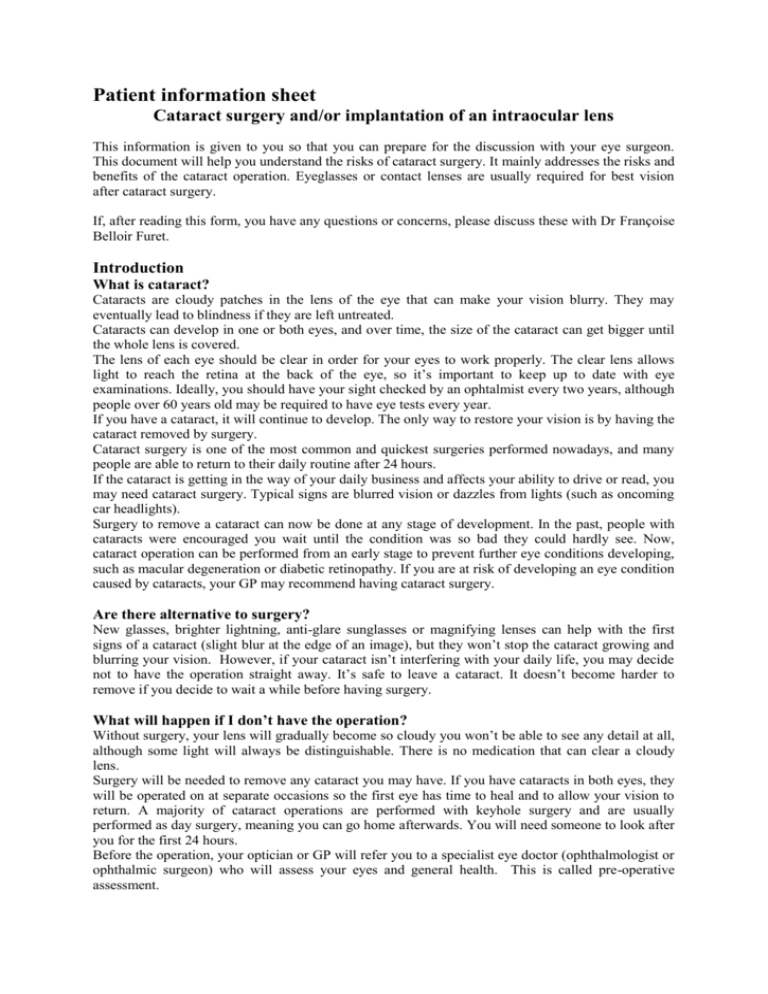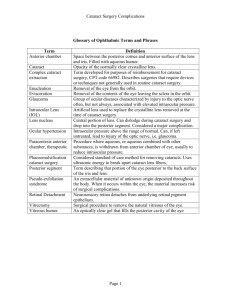Patient information sheet
advertisement

Patient information sheet Cataract surgery and/or implantation of an intraocular lens This information is given to you so that you can prepare for the discussion with your eye surgeon. This document will help you understand the risks of cataract surgery. It mainly addresses the risks and benefits of the cataract operation. Eyeglasses or contact lenses are usually required for best vision after cataract surgery. If, after reading this form, you have any questions or concerns, please discuss these with Dr Françoise Belloir Furet. Introduction What is cataract? Cataracts are cloudy patches in the lens of the eye that can make your vision blurry. They may eventually lead to blindness if they are left untreated. Cataracts can develop in one or both eyes, and over time, the size of the cataract can get bigger until the whole lens is covered. The lens of each eye should be clear in order for your eyes to work properly. The clear lens allows light to reach the retina at the back of the eye, so it’s important to keep up to date with eye examinations. Ideally, you should have your sight checked by an ophtalmist every two years, although people over 60 years old may be required to have eye tests every year. If you have a cataract, it will continue to develop. The only way to restore your vision is by having the cataract removed by surgery. Cataract surgery is one of the most common and quickest surgeries performed nowadays, and many people are able to return to their daily routine after 24 hours. If the cataract is getting in the way of your daily business and affects your ability to drive or read, you may need cataract surgery. Typical signs are blurred vision or dazzles from lights (such as oncoming car headlights). Surgery to remove a cataract can now be done at any stage of development. In the past, people with cataracts were encouraged you wait until the condition was so bad they could hardly see. Now, cataract operation can be performed from an early stage to prevent further eye conditions developing, such as macular degeneration or diabetic retinopathy. If you are at risk of developing an eye condition caused by cataracts, your GP may recommend having cataract surgery. Are there alternative to surgery? New glasses, brighter lightning, anti-glare sunglasses or magnifying lenses can help with the first signs of a cataract (slight blur at the edge of an image), but they won’t stop the cataract growing and blurring your vision. However, if your cataract isn’t interfering with your daily life, you may decide not to have the operation straight away. It’s safe to leave a cataract. It doesn’t become harder to remove if you decide to wait a while before having surgery. What will happen if I don’t have the operation? Without surgery, your lens will gradually become so cloudy you won’t be able to see any detail at all, although some light will always be distinguishable. There is no medication that can clear a cloudy lens. Surgery will be needed to remove any cataract you may have. If you have cataracts in both eyes, they will be operated on at separate occasions so the first eye has time to heal and to allow your vision to return. A majority of cataract operations are performed with keyhole surgery and are usually performed as day surgery, meaning you can go home afterwards. You will need someone to look after you for the first 24 hours. Before the operation, your optician or GP will refer you to a specialist eye doctor (ophthalmologist or ophthalmic surgeon) who will assess your eyes and general health. This is called pre-operative assessment. During this assessment, measurements of your eye wil be taken, to prepare for the artificial lens that will replace the natural blurring one. An appointment will probably be made for your operation to take place in a separate visit. There are three types of cataract surgery. They are : Phacoemulsification Extracapsular cataract surgery Intracapsular cataract surgery. Since cataract surgery is so common these days, these operations can often be completed within 45 minutes. Phacoemulsification usually takes 15-30 minutes, although extracapsular or intracapsular operations can take longer. Phacoemulsification Phacoemulsification is the most common cataract procedure. The surgeon puts drops into your eye to dilate (widen) your pupil. You will also be given a local anesthetic, which can be applied as drops or given as an injection into the issue around the eye. The surgeon then makes a tiny cut incision (2.4/2.8 mm) on the front surface of the eye (the cornea). A small probe is inserted into the cornea, which releases ultrasounds that help to break up the cataract into tiny pieces. The ultrasound probe is removed and a new probe is inserted, which sucks out the cataract. Once the entire cataract has gone, the surgeon inserts a small plastic lens through the incision in the cornea. The lens sits in the lens capsule, behind the pupil. The replacement lens is folded in half when it is inserted so it can fit through the incision in the cornea. When it is in place, it unfolds itself and adopts the natural position of the old lens. Extracapsular cataract surgery If your doctors think your lens is too awkward to be removed by phacoemulsification, they may suggest extracapsular surgery. The surgeon will need to make a larger incision in the cornea and through to the lens capsule, in order to remove the whole lens in one piece. Once the lens is removed, an artificial lens (such as those used in phacoemulsification) is inserted into the lens capsule. Intraocular cataract surgery This form of surgery is very rarely carried out, but is sometimes needed if the zonules (which support the lens) are too weak. Intraocular cataract surgery involves the removal of the entire lens, including the lens capsule. An artificial plastic lens is then inserted through the incision, where it sits over the pupil. The replacement lens There are several types of replacement lens available. Your doctor will decide which one will be the best for you. For any lens replacement, the quality of your vision after having cataract surgery depends on the correct measurements of your eye being taken BEFORE your operation. This pre-operative assessment ensures that the most appropriate lens replacement is chosen to fit with your eye and reduces the chance of poor vision afterwards. Risks : Cataract surgery is very common and the risks are very low. It’s estimated that the complication occurs in 2% of cases. Ask your surgeon to go through the possible risks with you before your operation. The most common risk is developing a condition called posterior capsule opacification. This occurs when a part of the lens capsule thickens and becomes cloudy. It can be treated, usually with laser surgery. Other possible complications after cataract surgery include: Infection in the eye Bleeding in the eye Inflammation in the eye Tearing of the lens capsule A bit of the cataract drooping into the back of the eye Damage to other parts of the eye, such as cornea. It is usually possible to treat any complications. However, occasionally, your vision may be worse than before or there may be permanent damage to the eye, causing loss of sight – but this is very rare. If a severe cataract is not treated, there is the possibility that loss of sight may be permanent. Childhood cataract surgery There are slightly more risks involved with childhood cataract surgery. They include : Increased pressure inside the eye (glaucoma) Squint(strabismus) Abnormalities affecting the eye pupil Vision becoming cloudy again (visual axis opacification or posterior capsule opacification) Separation of the retina from the inner wall of the eye (retina detachment) Infection –for example a rare bacterial infection (endophtalmitis) If childhood cataract is left untreated, the child may become blind. Even if cataract is removed, visual impairment or blindness can remain. After the operation : Your eye may be covered with a pad or piece of tape, which you can take off after a few hours. Your doctor or nurse will give you eye drops to help prevent infection and promote healing You can go home once you’ve made a full recovery from the anesthetic. Arrange for someone to collect you and take you home as you will not be allowed to drive yourself. Also arrange for someone to take care of you for the first 24 hours after surgery. You will need someone to look after you for the first 24 hours. Sensation usually returns to the eye within a few hours, and improved vision after a few days. Complete healing may take several months. You’ll be given a 24-hour contact telephone number and a date for a follow-up appointment – most surgeon see their patients one to three weeks from the operation It may be helpful to wear sunglasses or a hat when you leave hospital, as your eye could be sensitive to the sun. What should I do when I get home ? Take it easy for the first two or three days after the operation. Try not to touch or rub your eye. Keep soap and shampoo out of your eyes. In the past, the advice was not to bend after surgery, but this is no longer the case. You can bend, carry shopping, wash your face and hair and generally carry on your life as normal. It’s best not to swim for one week and you should avoid sports, such as tennis, where there is a risk you may get knocked in the eye. You should be able to read and watch tv almost immediately if you have reading glasses, but your vision may be blurry as your healing eye gets used to its new lens. You may have to get new reading glasses. If you suffer more than mild pain, experience loss of vision or if part of your eye starts to get red, you should immediately contact your hospital for advice. Painkillers like paracetamol should help mild pain. You can drive again when you can read a number plate at 20.5 meters. You may have to get new glasses to be able to do this again. After the operation, if you don’t have any other eye diseases, you should be able to : See things in focus, although you may still need glasses. Look into bright light without as much glare. Tell the difference between colors. Start to enjoy your usual activities, such as reading, knitting, working, watching tv, sports, driving. Results Most people (95 %) see an improvement with their sight almost immediately after surgery, although cataract surgery does not always completely restore your vision. Treatment usually involves surgery to replace the clouded natural lens with an artificial monofocal one, which has just one strength of focus. A monofocal lens will usually restore good distance vision, but you may still need to wear reading glasses for close work. Sometimes, the natural lens is replaced with either a monofocal or an accommodating lens, which allows you to focus on both near and distant objects. Some patients who have a multifocal lens fitted may not need to wear glasses at all after surgery. A review of studies by NICE showed that just 68 % of patients who had multifocal lenses implanted needed glasses after their operation, compared with 95 % of patients who were given monofocal lenses. It will take several weeks after the operation for your vision to settle down before your optician can give you a new glasses prescription, if necessary. Approximately 1 patient out of 100 will need a second operation. One patient out of 1000 will experience a complication that results in them having permanently worse vision, even when wearing glasses. Your ophtalmologist, Dr Françoise BELLOIR-FURET will be with you at your surgery to assist the surgeon, the fee for assistance is 50€ and the social security will rembourse you approximately 6€. If you have any questions do not hesitate to ask to the doctor. VERY IMPORTANT RECOMMENDATIONS After surgery please : take clean bed clothes, bedsheet and pillowcases, at home; Please see that the person who administers the eye drops wash their hands very carefully with soap and a hydroalcoholic solution before each eye drop. Do not let your pets sleep in your bed room. Avoid rubbing your eyes Carefully wash your hands each time you go to the toilets On the eve of the surgery day, take a shower and a shampoo so that your hair are clean NO RETURN HOME WILL BE ALLOWED THE DAY OF THE SURGERY IF YOU LIVE ALONE OR IF NO ARRANGEMENT TO HAVE SOMEONE LOOK AFTER YOU HAS BEEN MADE. Arrange for someone to take care of you for the first 24 hours after surgery. Insurance law forbids you from driving any vehicule for 48 hours after the operation. You must be accompanied when attending the required visit the following day. AVOID ANY STRONG PHYSICAL EFFORTS ----------------------------------------------------------------------------------------------------------------------------INFORMED CONSENT FORM Your doctor is obliged by law to prove that information has been supplied to the patient. So as it is asked you to sign this document, the copy of which will be kept by your doctor. The undersigned First name ................................................................................................................................................... Surname ..................................................................................................................................................... have read and plainly understood the explanation provided to me by Dr BELLOIR-FURET. The nature of the examination or the intervention, as well as its profits and its risks, were explained to me in words I understood. I have had all my questions answered to my satisfaction. I have been given enough time to think about it, and I agree I do not agree To the procedure which is proposed to be done. I also understand that if anything untoward occurs the surgeon will do as he/she thinks best for me at that time. Date Patient signature






